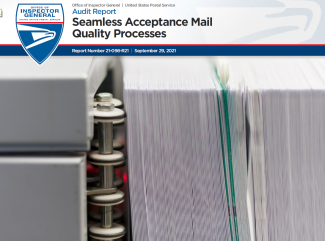Seamless Acceptance Mail Quality Processes
Objective
Seamless Acceptance automates the entry and verification of commercial mailings by leveraging electronic mailing documentation (eDoc). The eDoc contains detailed information on the mailing, and the Intelligent Mail barcode on pallets, trays, sacks, and mailpieces. Commercial mailings receive workshare discounts for types of mail preparation or mail processing activities (for example, presorting, prebarcoding, and transporting) normally performed by the Postal Service. Seamless Acceptance uses census and sampling verification to validate proper mail preparation for the discounts claimed and postage paid by mailers. The U.S. Postal Service regularly provides feedback to mailers on errors identified and assessments when errors exceed established thresholds. As of July 2021, there were 1,840 participants.
Our objective was to evaluate the use of Seamless Acceptance to assess mail quality and mail errors.
Findings
Opportunities exist for the Postal Service to improve Seamless Acceptance verification, strengthen the system, and enhance the appeals process. We found issues with the verification processes involving Nesting Sampling and Nesting/Sortation, pallet selection, and scanner functionality. Further, system enhancements were needed to reduce barcode uniqueness errors, Customer Registration Identification errors, and to make assessment details readily available. We also found opportunities to reduce the number of overturned assessments.
We conducted site visits at six mailing facilities and observed issues with Nesting Sampling, pallet sample selections, and scanners. Nesting Sampling verification was not conducted at two of the six facilities we visited and was conducted inconsistently at the remaining four sites. This type of verification determines whether scanned pieces are nested in a different tray or bundle than the tray or bundle identified in the eDoc. Employees at the facilities we visited did not understand the policy and/or did not think Nesting Sampling was required to be conducted. Additionally, although Nesting/Sortation errors are the second highest error type, assessment fees may be understated because of high error thresholds.
We also noted opportunities to strengthen the sampling verification of pallets at the sites visited. At five of the six sites, clerks did not verify if the mail provided to clerks by the mailer represented all completed pallets. Further, at one site the mailer selected the pallets for the clerks to sample from. When clerks sample from only a fraction of processed pallets, there is a risk that the sample is not representative of all available completed pallets. Also, when mailers select pallets to sample from, the integrity of the sampling methodology could be compromised, increasing the likelihood of potential revenue loss.
Additionally, at five of the six sites, personnel stated that scanners did not regularly operate as designed. For example, scanners experienced sudden malfunctions and failures, and did not provide the option to review the data before transmitting it to the system. Further, scanners did not always connect to Bluetooth scales, requiring clerks to enter weights manually. Postal Sevice personnel reported that scanners were malfunctioning because they were beyond their useful life and the batteries were expired. Scanner malfunctions created frequent interruptions and delayed the sampling process.
Further, mailers had concerns related to the 45-day unique barcode rule, potential misuse of customer registration identification, and unavailable detailed information of errors. Specifically:
- When mail is in the mail stream for longer than 45 days, the barcode may lose its uniqueness and cannot be matched with its associated eDoc. In February, the Postal Service waived 272 Seamless Acceptance assessments made in January 2021, valued at $524,290, for mailpieces that were processed after the 45-day uniqueness period. Management stated this occurred because of delays in processing mail during the peak season.
- Mailers who participate in Seamless Acceptance can use identifications owned by other mailers to register their mail in eDoc. There is no internal control that matches the identification number to the mailer provided on the eDoc.
- Many mailers stated that access to detailed information on undocumented piece errors was not readily available. This information is necessary to research the assessment. Error details are available in the Informed Visibility reporting system; however, mailers are not automatically provided access to the system when enrolled in Seamless Acceptance.
The Postal Service waives most of the issued assessments that are appealed. Assessment data between fiscal year (FY) 2016 and FY 2021, Quarter 2, shows the Postal Service reduced total assessments from an original amount of about $39 million to just over $5.6 million. Most of the overturned error assessments are related to mailers providing documentation to support payments made during the appeals process. The appeals process results in additional labor costs as Postal Service personnel must coordinate with mailers to review documentation and conduct additional research.
Recommendations
We recommended management:
- Determine if Nesting Sampling verification should be conducted at the Detached Mail Units and, if so, reiterate the policy to personnel to ensure this verification is conducted.
- Assess the appropriateness of corresponding error thresholds for Nesting/Sortation verification on mail processing equipment.
- Ensure existing pallet selection policies are consistent and adhered to and clerks are aware of the various sampling options.
- Ensure available scanners and scales are functional and new scanners include relevant functionality to complete accurate sampling.
- Consider enhancing the Seamless Acceptance system by revising the system logic to enable mail confirmation in the eDoc for more than 45 days; validating Customer Registration Identification; and including immediate access to the Informed Visibility Mail Tracking and Reporting system.
- Communicate common issues and error types that result in a high rate of overturned assessments with mailers to improve the assessment process.

